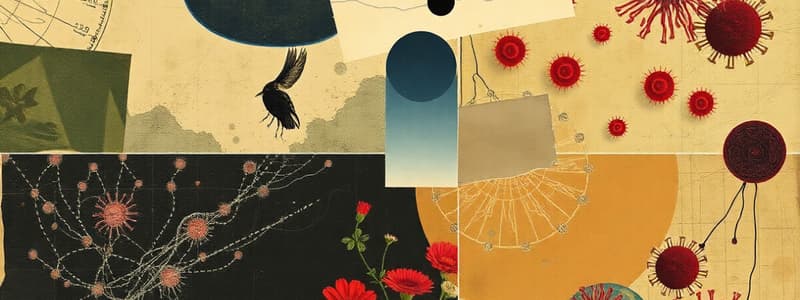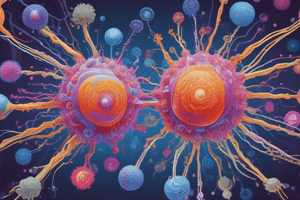Podcast
Questions and Answers
Describe a scenario where understanding the spatial arrangement of elements in a diagram is crucial for accurate interpretation.
Describe a scenario where understanding the spatial arrangement of elements in a diagram is crucial for accurate interpretation.
In circuit diagrams, the physical placement of components indicates connections and signal flow, which is essential for troubleshooting or modifying circuits.
Explain how the use of different visual cues (e.g., color, size, shape) in a diagram can enhance understanding and recall of complex information.
Explain how the use of different visual cues (e.g., color, size, shape) in a diagram can enhance understanding and recall of complex information.
Visual cues create distinct categories and hierarchies that facilitate quicker processing and memory retention by leveraging different cognitive pathways.
In the context of data representation, what are the advantages and disadvantages of using a diagram versus a table to present the same information?
In the context of data representation, what are the advantages and disadvantages of using a diagram versus a table to present the same information?
Diagrams excel at revealing patterns and relationships but can lack precise data values; tables offer detailed data but may obscure broader trends.
How might a diagram be used to illustrate a process or system that is difficult to visualize in reality?
How might a diagram be used to illustrate a process or system that is difficult to visualize in reality?
Explain how the effective use of labels and annotations in a diagram contributes to its overall clarity and interpretability.
Explain how the effective use of labels and annotations in a diagram contributes to its overall clarity and interpretability.
Explain the relationship between the terms 'source' and 'sink' in the context of the movement of a substance, according to the text.
Explain the relationship between the terms 'source' and 'sink' in the context of the movement of a substance, according to the text.
Based on the text, describe an example of a 'source-to-sink' relationship in a biological system.
Based on the text, describe an example of a 'source-to-sink' relationship in a biological system.
In the context of substance relocation/movement, what do ‘modifiers’ represent?
In the context of substance relocation/movement, what do ‘modifiers’ represent?
How might environmental conditions influence the efficiency of 'source-to-sink' relocation/movement?
How might environmental conditions influence the efficiency of 'source-to-sink' relocation/movement?
Predict what would happen if the 'sink' is removed or becomes non-functional.
Predict what would happen if the 'sink' is removed or becomes non-functional.
Describe one potential application of understanding 'source-to-sink' relationships in agriculture.
Describe one potential application of understanding 'source-to-sink' relationships in agriculture.
Explain how the concept of 'source-to-sink' relocation/movement could be applied to understand the spread of pollutants in an ecosystem.
Explain how the concept of 'source-to-sink' relocation/movement could be applied to understand the spread of pollutants in an ecosystem.
How might understanding ‘source-to-sink’ differences for nutrient allocations within a plant inform strategies for improving crop resilience to drought?
How might understanding ‘source-to-sink’ differences for nutrient allocations within a plant inform strategies for improving crop resilience to drought?
Flashcards
Stomach
Stomach
Relating to the stomach.
Blood Donation
Blood Donation
A type of blood donation.
Brain Function
Brain Function
Relating to the function of the brain.
Discovery
Discovery
Signup and view all the flashcards
Skin
Skin
Signup and view all the flashcards
Carbonate Formula
Carbonate Formula
Signup and view all the flashcards
Inclusion Symbol (➔)
Inclusion Symbol (➔)
Signup and view all the flashcards
Calcium Symbol
Calcium Symbol
Signup and view all the flashcards
Magnesium Symbol
Magnesium Symbol
Signup and view all the flashcards
Transformation (Reaction)
Transformation (Reaction)
Signup and view all the flashcards
Formation
Formation
Signup and view all the flashcards
Substitution Symbol
Substitution Symbol
Signup and view all the flashcards
Alteration
Alteration
Signup and view all the flashcards
Study Notes
- Here are study notes based on the images you provided.
Lymphopoiesis
- Starts with a hemocytoblast.
- Transports to the thymus, creating lymphoid T cells.
- Myeloid cells differentiate into NK cells and B cells.
- Mature T cells are produced and undergo apoptosis.
- Peripheral tissue and the bloodstream are involved.
Innate Immunity
- Involves complement proteins, leading to inflammation and fever.
Adaptive Immunity
- Cell-mediated immunity involves phagocytes, activating T cells to directly attack pathogens physically and/or chemically.
- Antibody-mediated immunity involves B cells transforming into plasma cells that produce circulating antibodies.
Antigen Presentation
- MHC I is present in all body cells
- Presents antigen or self markers on the cell surface
- MHC I is read by any immune cell, if there is no match, apoptosis occurs.
- MHC II is present in APCs (antigen-presenting cells) such as macrophages.
- APCs engulf and present antigens on the surface for T cells.
- The T cell matches the TCR (T-cell receptor).
- If it matches, then cell-mediated cytotoxity, or antibody-mediated killing occurs
- Child cells produce TCRs for remaining T cells.
- Helper CD4 cells are also produced.
Antibody-Mediated Immunity
- Sensitization: Antibody takes in an antigen and presents it on MHC II.
- Activation: TCR and CD4 match, activating the B cell.
- Division & Differentiation: B cells differentiate into plasma cells, producing more antibodies, which use seven mechanisms: activation of complement proteins, agglutination, stimulation of inflammation, neutralization (big hug), opsonization, and attraction of phagocytes.
Cytotoxic T Cells
- Secrete perforins, creating pores in the plasma membrane, causing the cell to lyse.
- Release cytokines to initiate apoptosis.
- Release lymphotoxins, disrupting metabolism.
Types of Antibodies
- IgG: Largest and most effective.
- IgE: Attaches to basophils and mast cells, stimulating inflammation.
- IgD: Located on the surface of B cells.
- IgM: First antibody secreted after exposure to an antigen; distinctive.
- IgA: Found in glandular secretions.
Lymphatic Drainage
- Top-right: Drains into the right lymphatic duct and right subclavian vein.
- Rest of body: Drains into the thoracic duct and left subclavian vein.
- Both systems drain into the superior vena cava.
Pulmonary Ventilation
- Atmospheric pressure compared to body pressure uses Boyle's Law.
- Volume is inversely proportional to pressure.
- The lungs can be filled using the concepts of volume and atmospheric pressure
- Inhalation: Contracting the diaphragm and intercostal muscles increases volume and decreases pressure.
- Exhalation: Contracting the diaphragm and intercostal muscles decreases volume and increases pressure.
Air Flow
- Air flows from the atmosphere through the nose, nasal cavity, pharynx, larynx, trachea, bronchi, and bronchioles.
- Smallest bronchioles connect to alveoli, where capillary exchange occurs.
- Oxygen deposits into the bloodstream, and carbon dioxide removes it for exhalation.
- Air flows externally from outside to lungs, and internally from the capillary to cells and tissues.
Gas Transport
- Oxygen binds to heme in hemoglobin, changing its shape.
- Carbon dioxide binds to globin in hemoglobin, which also changes its shape.
- Carbon dioxide transforms into carbonic acid in the plasma and dissolves within the plasma.
Hypercapnia and Hypocapnia
- Stimulus: High carbon dioxide levels (hypercapnia) or low carbon dioxide levels (hypocapnia).
- Receptor: Chemoreceptors in arteries and the medulla oblongata detect carbon dioxide levels.
- Brain: The control center.
- Effector: Respiratory muscles are stimulated or inhibited.
- Stimulating respiratory muscles increases the respiratory rate. Inhibiting respiratory muscles decreases the respiratory rate.
- This negates the stimulus (negative feedback).
- Result: Exhaling carbon dioxide or maintaining carbon dioxide, achieving homeostasis.
Digestive Tract
- Bolus enters through the mouth.
- Teeth aid in mastication (chewing).
- The tongue moves the bolus down
- Amylase, from salivary glands, breaks down carbohydrates.
- The bolus passes through the pharynx and esophagus to the stomach, which secretes digestive juices.
- Peristalsis is muscle contraction where things get pushed down
- Chyme enters the small intestine.
- Large intestines pulls digestive enymes from the liver and pancreas, there is a majority of water absorbtion
- Bulk goes to the intestines(large) which perform more absorption; waste;
Peristalsis
- Circular muscles behind the bolus contract.
- Longitudinal muscles ahead of the bolus contract.
- Waves of circular and longitudinal muscles force the bolus forward.
Deglutition (Swallowing)
- Includes the buccal, pharyngeal, and esophageal phases.
- Buccal: Mouth retracts tongue, and the soft palate + uvula seal off the nasopharynx.
- Pharyngeal: Epiglottis collapses, laryngopharynx elevates, and the larynx elevates.
- Esophageal: Peristalsis occurs, and the bolus enters the stomach as the lower esophageal sphincter opens.
Gastric Regulation
- Local response: Distention
- Neural response: Stretch receptors
- Hormonal response: Stimulates G cells
- Gastrin travels through the bloodstream to parietal and chief, reducing pH
Salivary Glands
- Include the parotid, sublingual, and submandibular glands; which all drain into the pharynx.
- The pharynx includes the nasopharynx, oropharynx, and laryngopharynx.
- Pylorus directs to: Duodenum, Jejunum, lleum
Large Intestine
- Includes the cecum, ascending colon, transverse colon, descending colon, sigmoid colon, recum, and anus
Gastric Regulation
- Cephalic Phase: Triggered by seeing, thinking, or smelling food.
- Vagus nerve triggers mucous, parietal, chief, and G cells.
- Parietal cells secrete intrinsic factor & hydrochloric acid.
- Chief cells secrete pepsinogen.
- G cells secrete gastrin.
- Mucous cells secrete mucus.
- Gastric Phase: Local response to distention.
- Intestinal Phase: Lipids & carbs in intestines trigger secretion of CCK & GIP.
- Low pH (<4.5) stimulates secretion of secretin.
Studying That Suits You
Use AI to generate personalized quizzes and flashcards to suit your learning preferences.



